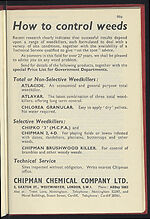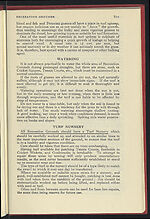1959-60
(946)
Download files
Complete book:
Individual page:
Thumbnail gallery: Grid view | List view

870
RECREATION GROUNDS
heap. Too-heavy dressings of leaf mould tend especially to produce
a spongy turf.
For those who are near the source of supply, and the question of
carriage does not enter, there are quite a number of by-products
of the manufacturing of alcoholic beverages, e.g., spent hops, malt
culms, kiln dust, pomace, etc., all of which are excellent sources
of organic matter and somewhat richer in nitrogen than stable
manure. In the case of spent hops it is advisable to have these
ground as otherwise they are very slow indeed in decomposing.
Residues of the
oil-extracting industries such as rape meal,
castor meal, sunflower meal, and other extracted meals and cakes
which are not suitable for cattle feeding may be included in the
compost. Like a number of the fermentation by-products, they
contain quite an appreciable amount of nitrogen and may result in
the compost having too great a forcing effect if used indiscriminately.
In addition to the above there are numerous other materials of
which profitable use can often be made but on which it is often
advisable to have expert opinion before purchasing. Such include
tobacco waste, leather waste (only very slightly decomposable),
corporation manures (i.e., residue from corporation fruit, vege-
table, fish, and meat markets) and certain sewage sludges. The
value of the latter for greenkeeping depends on the methods used in
the production of the sludge.
ARTIFICIAL FERTILISERS
Continual cutting of grass rapidly depletes the soil of essential
chemical salts. These should be replenished by the application
of adequate quantities of well-balanced fertilisers, preferably in the
spring, midsummer and autumn.
Complete fertilisers should be used where necessary and should be
supplemented by nitrogenous dressings, according to requirements.
Most manufacturers supply mixtures for Cricket Squares, Bowling
Greens, Tennis Courts, Cricket Outfields, Recreational Areas, etc.
The number of proprietary compound fertilisers offered by seeds-
men and manure merchants is legion and their constitution varies
according to the views of those responsible for their make-up and to
the sources of raw materials accessible to the particular merchant.
If secured from reliable firms they are usually dependable, but this
is an expensive way of supplying essential plant foods.
Rates of application will depend on the analysis of the compound
used and the state of the turf, but z ozs. per square yard (i.e., approxi-
mately 6 cwt. per acre) is usual. Lighter dressings may be given in
midsummer.
Bone meal is a useful source of phosphate and slow-acting nitrogen
and is particularly useful as a late winter dressing, or as a dressing
below new-laid turves. Like superphosphate, it is a frequent
constituent of compound fertilisers and when used with adequate
nitrogen, effects marked improvement to turf without encourage-
ment of the clovers.
Basic slag used alone is liable to favour clover, if present. Potassic
manures are most needed on light land. Nitrate of soda, dried
RECREATION GROUNDS
heap. Too-heavy dressings of leaf mould tend especially to produce
a spongy turf.
For those who are near the source of supply, and the question of
carriage does not enter, there are quite a number of by-products
of the manufacturing of alcoholic beverages, e.g., spent hops, malt
culms, kiln dust, pomace, etc., all of which are excellent sources
of organic matter and somewhat richer in nitrogen than stable
manure. In the case of spent hops it is advisable to have these
ground as otherwise they are very slow indeed in decomposing.
Residues of the
oil-extracting industries such as rape meal,
castor meal, sunflower meal, and other extracted meals and cakes
which are not suitable for cattle feeding may be included in the
compost. Like a number of the fermentation by-products, they
contain quite an appreciable amount of nitrogen and may result in
the compost having too great a forcing effect if used indiscriminately.
In addition to the above there are numerous other materials of
which profitable use can often be made but on which it is often
advisable to have expert opinion before purchasing. Such include
tobacco waste, leather waste (only very slightly decomposable),
corporation manures (i.e., residue from corporation fruit, vege-
table, fish, and meat markets) and certain sewage sludges. The
value of the latter for greenkeeping depends on the methods used in
the production of the sludge.
ARTIFICIAL FERTILISERS
Continual cutting of grass rapidly depletes the soil of essential
chemical salts. These should be replenished by the application
of adequate quantities of well-balanced fertilisers, preferably in the
spring, midsummer and autumn.
Complete fertilisers should be used where necessary and should be
supplemented by nitrogenous dressings, according to requirements.
Most manufacturers supply mixtures for Cricket Squares, Bowling
Greens, Tennis Courts, Cricket Outfields, Recreational Areas, etc.
The number of proprietary compound fertilisers offered by seeds-
men and manure merchants is legion and their constitution varies
according to the views of those responsible for their make-up and to
the sources of raw materials accessible to the particular merchant.
If secured from reliable firms they are usually dependable, but this
is an expensive way of supplying essential plant foods.
Rates of application will depend on the analysis of the compound
used and the state of the turf, but z ozs. per square yard (i.e., approxi-
mately 6 cwt. per acre) is usual. Lighter dressings may be given in
midsummer.
Bone meal is a useful source of phosphate and slow-acting nitrogen
and is particularly useful as a late winter dressing, or as a dressing
below new-laid turves. Like superphosphate, it is a frequent
constituent of compound fertilisers and when used with adequate
nitrogen, effects marked improvement to turf without encourage-
ment of the clovers.
Basic slag used alone is liable to favour clover, if present. Potassic
manures are most needed on light land. Nitrate of soda, dried
Set display mode to:
![]() Universal Viewer |
Universal Viewer | ![]() Mirador |
Large image | Transcription
Mirador |
Large image | Transcription
| Games and sports in the army > 1959-60 > (946) |
|---|
| Permanent URL | https://digital.nls.uk/248875336 |
|---|
| Description | 'Games and Sports in the Army' was an annual publication produced by the British War Office between the 1930s and 1960s. This included the Second World War. It outlines the rules and regulations for games and sports played by members of the armed forces. It features names and photographs of team members, and examples of contemporary advertising. |
|---|---|
| Shelfmark | GWB.52 |

